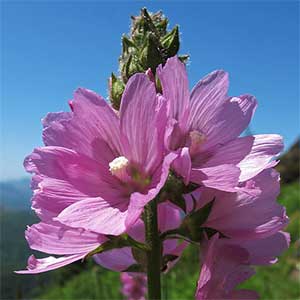Sidalcea cusickii
Sidalcea hirtipes
Cusick's checkerbloom, Cusick's checkermallow, Cusick's sidalcea
bluff mallow, bristly-stem checker-mallow, bristly-stem checkerbloom, hairy-stem checkermallow
usually several, clustered, erect, often purplish, often thick and hollow proximally, usually proximally ± scabrous, hairs stellate and distally stellate-hairy, sometimes glabrous.
several, scattered, erect, arising from rhizome apices, usually slightly hollow, densely, harshly bristly-hirsute, hairs stiff, pustular, simple, forked, or stellate, often 2–2.5 mm.
mostly cauline;
stipules persistent or deciduous, lanceolate, 6–8 × 1–1.5 mm;
proximal petioles 25–30 cm, 4–5 times as long as blade, reduced to 7–13 cm on midstem leaves and to 2–3 cm on distalmost leaves, these to 1/2 times as long as blades;
basal blades wide-ovate to orbiculate, shallowly to deeply, palmately 5–7(–9)-lobed, 6–13 × 6–13 cm, lobe margins toothed, teeth rounded, sometimes Ribes-like, base cordate, apex rounded, surfaces: abaxial densely stellate-pubescent, adaxial glabrous or sparsely stellate-pubescent on veins;
cauline blades round, divided nearly to base, 5–9-lobed, lobes again deeply incised to subentire, 10–20 × 10–20 cm, distalmost 5–7-cleft to base.
basal and cauline;
stipules linear-subulate, 6–8 × 1–1.5 mm;
petioles of proximal leaves 20–30 cm, 3 times as long as blades, reduced distally to 1/2 times as long as blades;
blades: basal and proximalmost orbiculate to reniform, shallowly 5–9-lobed, 10–15 × 10–15 cm, thick, base narrowly cordate, lobe margins coarsely crenate-dentate, apex rounded, surfaces coarsely hirsute, hairs stiff;
distal orbiculate, deeply palmately 5–7-lobed, incised ± to base, lobes sometimes lobed again, base cuneate, apex acute, deeply 2–3-toothed, surfaces long-hirsute or with 2–4-rayed, stellate hairs abaxially.
erect, spiciform, dense, calyces usually conspicuously overlapping in flower and sometimes in fruit, usually 20–30-branched per primary stem, 20+-flowered, elongate, not 1-sided, most flowers usually open at same time, branches relatively short, each spike unit 6 cm, longer in fruit;
bracts ovate-lanceolate to subulate, undivided, 1–6(–10) mm, subequal or longer than pedicels, much shorter than calyx.
erect, spiciform to subcapitate, dense, calyces usually conspicuously overlapping in flower and sometimes in fruit, proximals usually long-pedunculate, unbranched or branched, 20+-flowered, 10+ flowers usually open on spike at same time, not interrupted, not 1-sided, usually to 8 cm, usually not elongate but sometimes slightly elongated in some populations and to 20 cm in fruit;
bracts paired or single, linear, distal undivided, proximal distinct to base, 6 mm, mostly slightly longer than pedicels.
1–2(–5) mm;
involucellar bractlets absent.
1–3(–5) mm;
involucellar bractlets absent.
bisexual or unisexual and pistillate, pistillate plants more frequent than bisexual ones, some flowers may be staminate, plants gynodioecious;
calyx urceolate with swollen base especially in young fruit, pistillate 6–8 mm, bisexual 6–10 mm, strongly reticulate-veined, usually finely stellate-puberulent, sometimes glabrate, lobes usually purple tinted;
petals 7 or 8, pale pink, pinkish rose, or rose-purple, usually neither pale-veined nor white at base, pistillate 8–12(–14) mm, staminate or bisexual (10–)11–19(–23) mm;
staminal column 5–6 mm, hairy;
anthers white;
stigmas 7 or 8.
bisexual or unisexual and pistillate, plants gynodioecious;
calyx often purple tinted, 9–11 mm, to 11–16 mm in fruit, margins ciliate, hairs 1–2 mm, surfaces finely stellate-hairy at base and with coarser, longer, simple and stellate hairs apically;
petals usually pale pink to rose-lavender, rarely white, slightly or not pale-veined, (9–)10–21 mm, pistillate often 9–14 mm;
staminal column 5–7(–10) mm, hairy;
anthers white;
stigmas 5–10.
2 mm.
2.5–3.5 mm.
6 mm diam.;
mericarps 7 or 8, 3 mm, apical margins ± rounded, sides smooth or slightly reticulate-veined, not pitted, back essentially smooth, very sparsely glandular-puberulent near tip, mucro 0.5–1 mm.
7–8 mm diam.;
mericarps 5–10, 3.5–4 mm, glabrous or sparsely stellate-puberulent, roughened, prominently reticulate-veined, sides rugose and pitted, back less so, mucro 0.6–0.8 mm.
= 20.
= 60.
Sidalcea cusickii
Sidalcea hirtipes
Sidalcea cusickii is showy and distinctive. It has been confused with S. campestris, S. hendersonii, S. nelsoniana, S. oregana (subsp. spicata), S. setosa, and S. virgata. Molecular data support a close relationship with S. hendersonii and S. virgata (K. Andreasen and B. G. Baldwin 2003b). Hitchcock distinguished subsp. cusickii and subsp. purpurea, the latter with purple, ciliate calyx lobes and stem proximally glabrous and thought to be more closely related to S. hendersonii and S. nelsoniana. The two variations overlap in range and characteristics and are not recognized here. There appear to be two groups of populations at different elevation ranges with little overlap. Overall, S. cusickii can be distinguished by its range and by its spikelike, many-flowered, thick, compounded racemes in which essentially all of the flowers are open at the same time. It is also unusual in the preponderance of pistillate-flowered individuals in a given population and the presence of what appear to be truly staminate, rather than bisexual, flowers on some individuals. It is found in the Willamette and Umpqua valley region in Douglas, Josephine, and Lane counties.
(Discussion copyrighted by Flora of North America; reprinted with permission.)
Of conservation concern.
Sidalcea hirtipes is uncommon and known from Clatsop, Lincoln, and Tillamook counties in Oregon and Clark, Lewis, and Wahkiakum counties in Washington. Its elevation and habitat vary, and it seems as much at home on steep coastal cliffs as in more inland, historic prairies and mountain meadows. Populations can appear to be large because of the long-rhizomatous and clonal nature of the plants; they are few and local. It is threatened by grazing, loss of habitat, fire suppression, road construction and maintenance, and changes in hydrology. It is a candidate for listing in Oregon and has been listed as endangered in Washington. Sidalcea hirtipes is characterized by its coarse indument of bristle hairs, its generally compact spikelike inflorescences, its relatively few, large, erect, hirsute leaves, and, especially, its extensive, coarse rhizomes. The inflorescences in some populations are elongated in fruit; its range, hirsute indument, and thick leaves along with coarse rhizomes help to distinguish it from other species. Stem internode length varies depending on habitat, as in many other Sidalcea. Molecular data suggest a relationship among S. hirtipes and S. asprella, S. celata, and S. gigantea (K. Andreasen and B. G. Baldwin 2003).
(Discussion copyrighted by Flora of North America; reprinted with permission.)
